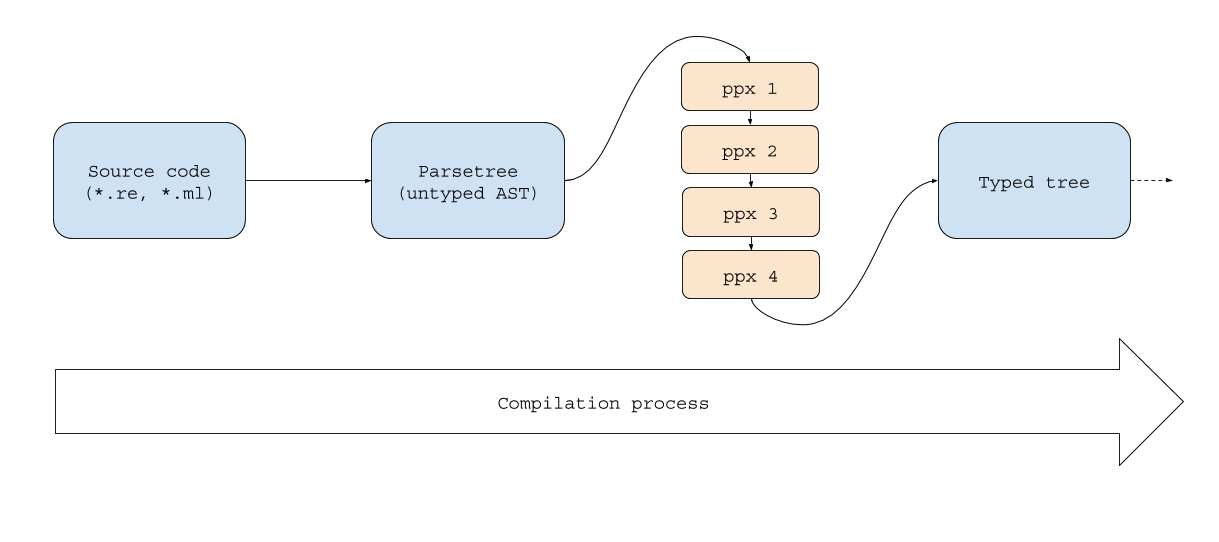When two worlds collide: using esy to consume BuckleScript ppxs from source
In this article, we will take a look at the existing landscape of ppx rewriters for BuckleScript. We will also see the work involved in preparing and publishing a ppx rewriter for their authors. Finally, we will present a different approach to publish and consume ppx rewriters in BuckleScript that relies on the cross-platform package manager esy.

🤓 What is a ppx
In Reason and OCaml there is a system called "pre-processor extensions", which are also known as ppx rewriters, or just "ppxs". As their name states, these programs pre-process the code: they run just after the compilation parsing stage has successfully ended, and before the type checking and other deeper parts of the compilation process start.

High-level diagram showing where the ppx processing happens in the compilation process
Ppxs were originally introduced when a command line option -ppx was added to the OCaml compiler. This option allows to pass multiple paths to native applications binaries. These programs are then executed during the compilation of each file. Once the compilation starts, each ppx binary file defined in the list is given a serialized representation of the abstract syntax tree (AST) by the compiler, and produces another serialized AST. This process continues for all the ppxs, and all the modules built by the compiler.
🔧 How ppxs work in BuckleScript today
In BuckleScript, as it is a fork of OCaml, ppxs have been available from early on. BuckleScript exposes the command line flag -ppx from the bsconfig.json file, which is used to configure the build process (one can think of it as webpack.config.js). The property to set the list of ppx rewriters that will run is ppx-flags, so if we want to run 3 ppxs we will write something like:
"ppx-flags": [
"graphql-ppx",
"my-cool-ppx",
"destroy-all-code-ppx"
],
So, if ppxs have been working for a long time in OCaml, and BuckleScript exposes a way to take advantage of that feature, where is the issue?
✍️ Being a BuckleScript ppx author
BuckleScript publishes regular releases of the compiler itself. Pre-built binaries for the most used platforms: macOS, Linux and Windows.
It also provides a really familiar way —at least for JavaScript developers— to make use of npm to enable the publication of source code for libraries or bindings packages. They can be written in Reason or OCaml syntax, and then they get compiled with the rest of the application that they are part of. BuckleScript application developers have access today to an increasing ecosystem of packages, published by hundreds of authors: more than 800 results in npm are returned for the word bucklescript.
However, as of today, the BuckleScript compiler does not support any kind of system to build and link native libraries at compile time, like it does with BuckleScript-written packages. But who, you might ask, would want to write and use native libraries for a compiler that targets Javscript, which is platform independent? People who make and use ppxs, that's who! A ppx has to be native code because the AST that the compiler passes to it is in a binary format, and the libraries to work with them use native functions. An even if it was possible, running ppxs in something else than native would produce a huge drop in compilation performance.
The absence of a build story for native libraries in BuckleScript poses some challenges for ppx authors. If they want to publish a ppx rewriter, they have to start asking the same questions that BuckleScript itself has to solve for the compiler releases:
- "What OS and versions do I want to support?"
- "How do I prepare pre-build artifacts for them?"
- "How do I publish the binaries?"
- "Should I have one package with all binaries, or many?"
But ppxs are generally projects of different nature (and definitely different scale!) than a compiler.
A ppx author generally has many ongoing projects, has to maintain other libraries, or even other ppxs, and probably prefers to avoid spending much time solving problems related to publishing cross-platform binaries, which generally requires a different skills and knowledge than building and designing software.
Besides, ppx authoring gets more intimidating when taking into account that most BuckleScript users came originally from JavaScript, where all the intricacies of native applications development are abstracted away. This mismatch results in ppxs remaining less accessible for a very large part of the community, which is —in my opinion— a shame, considering how creative and innovative this community has been.
Even with those challenges, today the BuckleScript ppx ecosystem is seeing a healthy activity, with several ppxs being published for multiple platforms. Which speaks volumes about their authors and maintainers passion, technical skills and generosity, and the community desire to experiment and explore new ways to improve the way BuckleScript apps are built.
These are some examples of ppxs for BuckleScript:
graphql_ppx, probably the most known ppx in the community, publishes binaries for Linux and macOSdecco, a ppx that generates (de)serializers for user-defined types, publishes as well for Linux and macOS as wellbs-emotion-ppxoffers builds for Linux, macOS and Windows, thanks to Azure pipelines, and the work done by Ulrik Strid and Jordan Walke in the hello-reason example repo.- There are even more sophisticated cases like
bs-deriving, which takes an existing native OCaml ppx (ppx-deriving) and wraps it to make it usable from BuckleScript. It provide builds for Linux and macOS.
This covers just the surface, but I hope it gives a glimpse of the amount of effort that goes into building and maintaining these packages, and make them accessible to as many people as possible.
⛲️ Using ppxs from source
What if ppx authors had a way to publish their ppxs source code directly, without caring about the platforms it will be deployed, but at the same time keeping the users experience as straight forward as possible when using them?
In such a situation, a library author could use the exact same process that they use for regular BuckleScript libraries or bindings in order to publish a ppx: write the source code, npm publish. Boom. Done.
But how would users build the the ppxs source code?
🌎 esy: the first cross-language package manager
esy is a package manager that helps managing either native OCaml or Reason packages, or JavaScript packages. It does so by following closely the model that was so successful for JavaScript ecosystem: define dependencies in a package.json file (esy allows to use esy.json alternatively as well).
Besides working with both npm and opam (OCaml packages repository) it includes a lot of other nice features, some of them inspired by JavaScript package managers:
- lock files, reproducible builds
- cross-project cache (no more same library stored in many
node-modulesfolders) - similar commands to those in known package managers like Yarn or npm:
esy install,esy addetc.
Users that would like to use ppxs from source, or that can't find a specific ppx published in their OS of choice, could use esy to have access to them.
🕵️♀️ Example: use a ppx foo from source
The first thing to do would be to install esy, if you have not installed it yet.
Once esy is installed, let's say we want to use an existing ppx foo that has been already published to npm so it can be consumed from source. We would add an esy.json file to our BuckleScript app:
{
"name": "my_bucklescript_app",
"dependencies": {
"foo": "^1.0.0"
}
}
Then add the ppx-flags setting, as shown above, in bsconfig.json:
"ppx-flags": [
"esy x foo"
],
This is the main difference with the previous approach: instead of calling directly a pre-built binary that the ppx author prepared in advance, we are just telling BuckleScript to ask esy to run it.
After this, we can just build and run our BuckleScript app normally using bsb -make-world or just bsb.
🚀 Upsides
- Better composition of ppxs: This idea requires a change of thinking for ppx authors. Instead of the current pattern, where authors just publish binaries, the authors would take a step up the build-system ladder and just publish source code (this is how ppxs work for OCaml). This opens up room for discussion in the BuckleScript community about which patterns from the existing OCaml community around ppx consumption we could adopt into our own workflow.
- Improved performance: It would allow to start exploring ways to support better composition for ppxs, like the OCaml community did in the past with ppxlib. This kind of optimizations allow to link all ppxs together so all ppxs run as part of the same step avoiding most of the serialization and deserialization of the AST.
- Accessibility: It would empower more BuckleScript users to create and maintain their own ppxs and using native tooling, by building on top of a JavaScript-friendly workflow like esy.
😞 Downsides
The proposed approach has downsides as well, mostly for ppx consumers. It introduces another tool to manage the build process (esy) with everything that that entails: making sure everyone has it, runs same version, is added to scripts and build processes, CI, etc.
One mitigation for this is could be to include esy && bsb in the build commands defined in package.json. esy has a very aggresive way to cache artifacts, taking roughly 100ms or less to run when all dependencies have been built already.
Another downside is build time: because ppxs are consumed from source, that means one has to build them before using them. esy heavily caches previous builds so the 2nd time and after they get instant, but nothing beats the ppx author pre-building the ppx in advance of course.
Lastly, even if this "build from source" approach is a small step towards a more seamless integration between OCaml and BuckleScript ecosystems, there are still many ppxs that, due to their usage of tooling, libraries or C code, which are not available in BuckleScript, are not directly usable. The recommendation for those wanting to try OCaml ppxs is to test each case individually, we have been successful when using this approach for simpler ppxs like ppx_blob but other ppxs that are more complex —like ppx_deriving— definitely require more effort.
📚 Resources
-
The demo repo
hello-ppx-esyhas been updated with the ideas from this post. The repo contains a very small ppx to transform the[%gimme]extension into the number 42 (I promise: ppxs can do much more than that! 😆). You can find a sample BuckleScript project here. -
If you are interested on learning more about ppxs in OCaml, I recommend reading the blog post: "An introduction to OCaml PPX ecosystem".
-
If you want to learn more about how to publish cross-platform binaries from native libraries or apps, make sure to check the
hello-reasonwhich contains a very polished pipeline setup to build binaries for the three main OS platforms. -
For those wanting to learn about the past, present and future of ppxs in the OCaml ecosystem, Jeremy Dimino posted a fascinating thread in OCaml Discourse.
Thanks for reading 🙌 If you have any comments or suggestions, please let me know on Twitter.
Keep shipping! 🚀
Murphy Randle made this article better by reviewing an earlier version of it, ¡muchas gracias!. Thanks as well to Antonio Monteiro for the discussions and thought sharing that led to this idea.